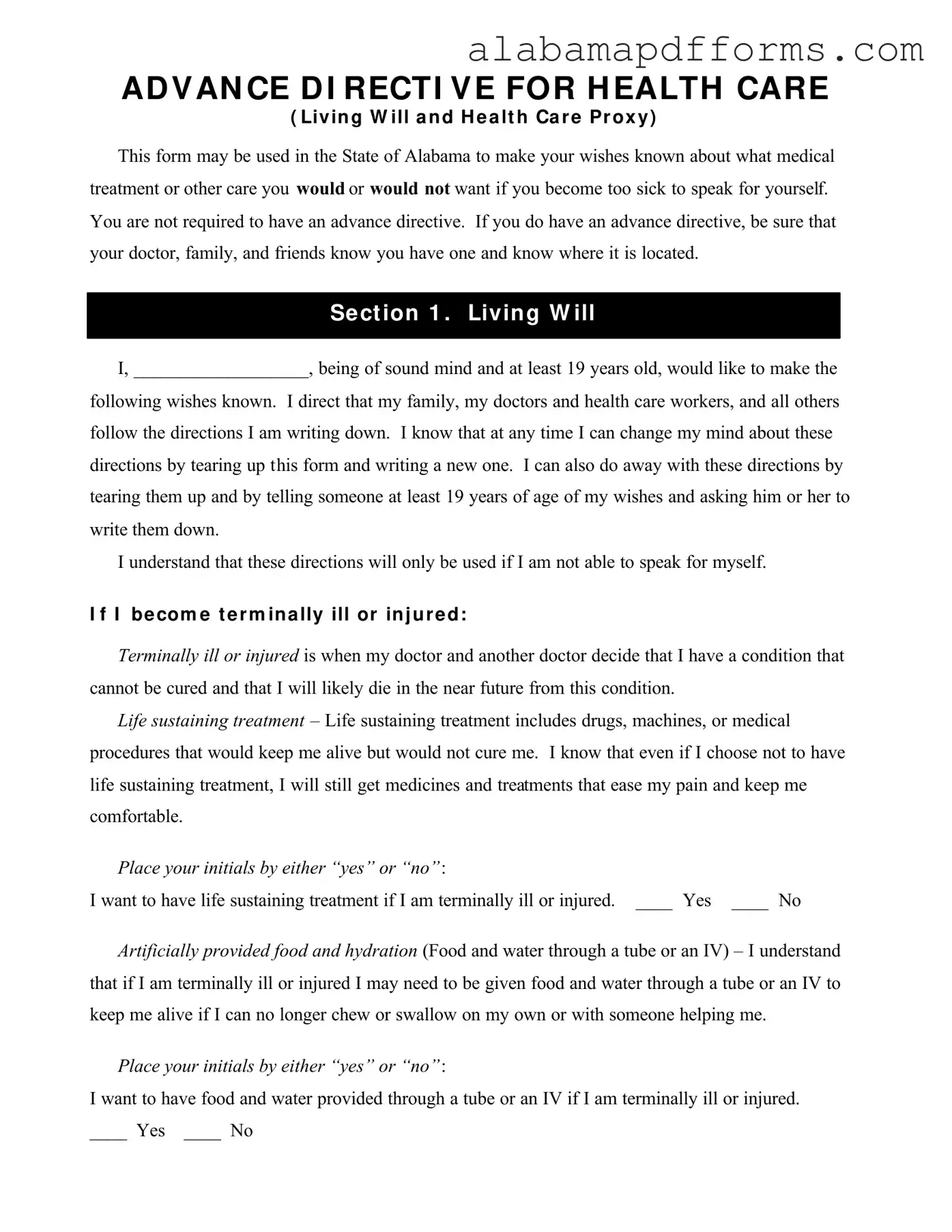AD V AN CE D I RECTI V E FOR H EALTH CARE
( Liv in g W ill a n d H e a lt h Ca r e Pr ox y )
This form may be used in the State of Alabama to make your wishes known about what medical treatment or other care you would or would not want if you become too sick to speak for yourself. You are not required to have an advance directive. If you do have an advance directive, be sure that your doctor, family, and friends know you have one and know where it is located.
Se ct ion 1 . Livin g W ill
I, ___________________, being of sound mind and at least 19 years old, would like to make the
following wishes known. I direct that my family, my doctors and health care workers, and all others follow the directions I am writing down. I know that at any time I can change my mind about these directions by tearing up this form and writing a new one. I can also do away with these directions by tearing them up and by telling someone at least 19 years of age of my wishes and asking him or her to write them down.
I understand that these directions will only be used if I am not able to speak for myself.
I f I be com e t e r m in a lly ill or in j u r e d:
Terminally ill or injured is when my doctor and another doctor decide that I have a condition that cannot be cured and that I will likely die in the near future from this condition.
Life sustaining treatment – Life sustaining treatment includes drugs, machines, or medical procedures that would keep me alive but would not cure me. I know that even if I choose not to have life sustaining treatment, I will still get medicines and treatments that ease my pain and keep me comfortable.
Place your initials by either “yes” or “no”:
I want to have life sustaining treatment if I am terminally ill or injured. ____ Yes ____ No
Artificially provided food and hydration (Food and water through a tube or an IV) – I understand that if I am terminally ill or injured I may need to be given food and water through a tube or an IV to keep me alive if I can no longer chew or swallow on my own or with someone helping me.
Place your initials by either “yes” or “no”:
I want to have food and water provided through a tube or an IV if I am terminally ill or injured.
____ Yes ____ No
I f I Be com e Pe r m a n e n t ly U n con sciou s:
Permanent unconsciousness is when my doctor and another doctor agree that within a reasonable degree of medical certainty I can no longer think, feel anything, knowingly move, or be aware of being alive. They believe this condition will last indefinitely without hope for improvement and have watched me long enough to make that decision. I understand that at least one of these doctors must be qualified to make such a diagnosis.
Life sustaining treatment – Life sustaining treatment includes drugs, machines, or other medical procedures that would keep me alive but would not cure me. I know that even if I choose not to have life sustaining treatment, I will still get medicines and treatments that ease my pain and keep me comfortable.
Place your initials by either “yes” or “no”:
I want to have life-sustaining treatment if I am permanently unconscious. ____ Yes ____ No
Artificially provided food and hydration (Food and water through a tube or an IV) – I understand that if I become permanently unconscious, I may need to be given food and water through a tube or an IV to keep me alive if I can no longer chew or swallow on my own or with someone helping me.
Place your initials by either “yes” or “no”:
I want to have food and water provided through a tube or an IV if I am permanently unconscious.
____ Yes ____ No
O t h e r D ir e ct ion s: Please list any other things you want done or not done.
In addition to the directions I have listed on this form, I also want the following:
__________________________________________________________________________________
__________________________________________________________________________________
__________________________________________________________________________________
__________________________________________________________________________________
If you do not have other directions, place your initials here:
____ No, I do not have any other directions.
Se ct ion 2 . I f I ne e d som e one t o spe a k for m e .
This form can be used in the State of Alabama to name a person you would like to make medical or other decisions for you if you become too sick to speak for yourself. This person is called a health care proxy. You do not have to name a health care proxy. The directions in this form will be followed even if you do not name a health care proxy.
Place your initials by only one answer:
_____ I do not want to name a health care proxy. (If you check this answer, go to Section 3)
_____ I do want the person listed below to be my health care proxy. I have talked with this person
about my wishes.
First choice for proxy: ________________________________________
Relationship to me: __________________________________________
Address: ____________________________________________________
City: ____________________________ State _______ Zip ___________
Day-time phone number: _______________________________________
Night-time phone number: ______________________________________
If this person is not able, not willing, or not available to be my health care proxy, this is my next
choice:
Second choice for proxy: _______________________________________
Relationship to me: __________________________________________
Address: ____________________________________________________
City: ____________________________ State _______ Zip ___________
Day-time phone number: _______________________________________
Night-time phone number: ______________________________________
Instructions for Proxy
Place your initials by either “yes” or “no”:
I want my health care proxy to make decisions about whether to give me food and water through a tube or an IV. ____ Yes ____ No
Place your initials by only one of the following:
____ |
I want my health care proxy to follow only the directions as listed on this form. |
_____ |
I want my health care proxy to follow my directions as listed on this form and to make any |
|
decisions about things I have not covered in the form. |
_____ |
I want my health care proxy to make the final decision, even though it could mean doing |
|
something different from what I have listed on this form. |
Se ct ion 3 . Th e t h in gs list e d on t h is for m a r e w h a t I w a n t .
I understand the following:
§If my doctor or hospital does not want to follow the directions I have listed, they must see that I get to a doctor or hospital who will follow my directions.
§If I am pregnant, or if I become pregnant, the choices I have made on this form will not be followed until after the birth of the baby.
§If the time comes for me to stop receiving life sustaining treatment or food and water through a tube or an IV, I direct that my doctor talk about the good and bad points of doing this, along with my wishes, with my health care proxy, if I have one, and with the following people:
____________________________________________________________________
____________________________________________________________________
Se ct ion 4 . M y signa t ur e
Your name: _______________________________________________________
The month, day, and year of your birth: _________________________________
Your signature: ____________________________________________________
Date signed: _______________________________________________________
Se ct ion 5 . W it n e sse s ( n e e d t w o w it n e sse s t o sign )
I am witnessing this form because I believe this person to be of sound mind. I did not sign the person’s signature, and I am not the health care proxy. I am not related to the person by blood, adoption, or marriage and not entitled to any part of his or her estate. I am at least 19 years of age and am not directly responsible for paying for his or her medical care.
Name of first witness: ___________________________________
Signature: _____________________________________________
Date: _________________________________________________
Name of second witness: _________________________________
Signature: _____________________________________________
Date: _________________________________________________
Se ct ion 6 . Sign a t u r e of Pr ox y
I, ____________________________________________, am willing to serve as the health care proxy.
Signature: ________________________________________ |
Date: _________________________ |
Signature of Second Choice for Proxy:
I, __________________________, am willing to serve as the health care proxy if the first choice
cannot serve.
Signature: ________________________________________ |
Date: _________________________ |




